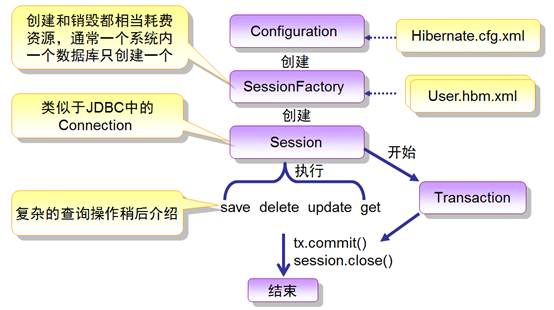Hibernate系列教程之一(Hibernate结构)
作者认为学习计算机的相关知识,需要通过下面几种步骤,不仅能从本质上了解它,同时也能更灵活的掌握:
1. 了解此项技术的产生的背景(传统的做法如何,为什么要出现这项技术,试图去解决什么问题)
2. 此项技术采用的思想(总体框架,整体分几个模块或者分几层)
3. 每层对应传统方法的哪个步骤或者对应传统方法的是哪个部分
4. 技术对传统方式的优缺点(自己总结)
下面咱们来看下hibernate的工作原理,也算是对自己之前掌握的只是的一种总结。
看下图:

传统的数据库操作,一般利用SQL语句通过JDBC或者ODBC驱动DBMS完成数据的CRUB,业务数据的维持完全交由了程序来完成。面向关系的数据库操作已经不太能跟软件开发中的OO思想相协调,一定程度上来说无法满足OO开发的需要。
同时SQL对DBMS来说不是线程安全的,所以在每打开一次连接,进行相应操作后应立刻关闭连接。在大数据量的访问时,需要手工建立、管理缓冲池来满足系统高并发的需求。对数据库开发人员来说无疑是一种高要求。
Hibernate是为了解决上述问题应运而生的技术,负责数据持久化的工作。
它不但能够通过配置映射文件屏蔽对数据源中表的操作,同时会话层Session负责提供了连接池Pool,对大并发度的数据库操作进行了缓冲处理。其映射文件对应的类与数据库的表是一一对应关系,与软件开发的思想结合的更好更密切。
通过上图可以看出Hibernate框架大致包括了四个部分:
x Configuration层
x SessionFactory层
x Session会话
x 事务处理
Hibernate在运行过程中整个工作流程描述如下:
Hiberante启动初始化,读取hibernate.cfg.xml(文件名不一定是hibernate.cfg.xml,只不过默认是hiberante.cfg.xml,如若更改为hibernate_common.xml,那么在HibernateSessionFactory中需要更改默认的配置文件名,默认文件名在HibernateSessionFactory中表现为一个常量)。
private static String CONFIG_FILE_LOCATION = "/hibernate_common.xml";
首先让我们看下Hibernate建议给我们的HibernateSessionFactory内容:
import org.hibernate.HibernateException;
import org.hibernate.Session;
import org.hibernate.cfg.Configuration;
import org.hibernate.cfg.AnnotationConfiguration;
/**
* Configures and provides access to Hibernate sessions, tied to the
* current thread of execution. Follows the Thread Local Session
* pattern, see {@link http://hibernate.org/42.html }.
*/
public class HibernateSessionFactory {
/**
* Location of hibernate.cfg.xml file.
* Location should be on the classpath as Hibernate uses
* #resourceAsStream style lookup for its configuration file.
* The default classpath location of the hibernate config file is
* in the default package. Use #setConfigFile() to update
* the location of the configuration file for the current session.
*/
private static String CONFIG_FILE_LOCATION = "/hibernate_common.xml";
private static final ThreadLocal<Session> threadLocal = new ThreadLocal<Session>();
private static Configuration configuration = new AnnotationConfiguration();
private static org.hibernate.SessionFactory sessionFactory;
private static String configFile = CONFIG_FILE_LOCATION;
static {
try {
configuration.configure(configFile);
sessionFactory = configuration.buildSessionFactory();
} catch (Exception e) {
System.err
.println("%%%% Error Creating SessionFactory %%%%");
e.printStackTrace();
}
}
private HibernateSessionFactory() {
}
/**
* Returns the ThreadLocal Session instance. Lazy initialize
* the <code>SessionFactory</code> if needed.
*
* @return Session
* @throws HibernateException
*/
public static Session getSession() throws HibernateException {
Session session = (Session) threadLocal.get();
if (session == null || !session.isOpen()) {
if (sessionFactory == null) {
rebuildSessionFactory();
}
session = (sessionFactory != null) ? sessionFactory.openSession()
: null;
threadLocal.set(session);
}
return session;
}
/**
* Rebuild hibernate session factory
*
*/
public static void rebuildSessionFactory() {
try {
configuration.configure(configFile);
sessionFactory = configuration.buildSessionFactory();
} catch (Exception e) {
System.err
.println("%%%% Error Creating SessionFactory %%%%");
e.printStackTrace();
}
}
/**
* Close the single hibernate session instance.
*
* @throws HibernateException
*/
public static void closeSession() throws HibernateException {
Session session = (Session) threadLocal.get();
threadLocal.set(null);
if (session != null) {
session.close();
}
}
/**
* return session factory
*
*/
public static org.hibernate.SessionFactory getSessionFactory() {
return sessionFactory;
}
/**
* return session factory
*
* session factory will be rebuilded in the next call
*/
public static void setConfigFile(String configFile) {
HibernateSessionFactory.configFile = configFile;
sessionFactory = null;
}
/**
* return hibernate configuration
*
*/
public static Configuration getConfiguration() {
return configuration;
}
}
当有需要通过hiberante进行与数据库的交互时,此时sessionFactory生产一个session进行与数据源的会话。
Tips:对数据源的操作是通过sessionFactory生成一个一个session(看明白前面,是不是可以想象出连接池的建立在这种模式下很容易就能实现?)。
前面说过JDBC对DBMS的操作不是线程安全的,hibernate也是如此。所以hibernate中对数据源的每次操作都需要申请一个session,可以理解为一次打开数据源的连接,一次操作结束,session要立刻关闭,因为Hibernate中也不是线程间安全的。
至此,数据源连接已经完成,那么后续需要讲内存中的数据写入数据库系统,开启一个事务,然后进行数据库操作,成功执行,事务结束,同时关闭session。
在这章节里面,咱们不去讨论hbm文件映射,也不去讨论映射文件中类型的关系,更不去看主键的生成策略。
仅仅告诉梳理了hibernate的操作流程和大致步骤。
详细的后续章节会介绍。
出处:http://www.cnblogs.com/weisteve/
本文版权归作者和博客园共有,欢迎转载,但未经作者同意必须保留此段声明,且在文章页面明显位置给出原文连接,否则保留追究法律责任的权利。


